Please enable JavaScript in your web browser to get the best experience.


Desire, love, identity – an LGBTQ tour of the British Museum
Gallery talks & tours / 14 Apr 2024 – 26 Apr 2024
Adults and children aged 12+
A tour in the Mesopotamia (6000–1500 BC) gallery (Room 56).
Share the page
- Share on Facebook
- Share on X (formerly Twitter)
Event information
14 apr 2024 – 26 apr 2024.
14.30–15.40
Meeting point
Information Desk (Great Court)
Free, advance booking essential
Sign up to our emails and be the first to hear about upcoming events.
Explore objects in the collection linked to the themes of desire, love and identity.
Join our volunteer-led tour and discover a fascinating selection of objects with LGBTQ (lesbian, gay, bisexual, transgender and queer) connections. The tour ranges from the ancient world to the present day, and includes some of the most famous artworks on display.
Booking information:
- The tour will begin at 14.30 and will last for 70 minutes. Please meet at the Information Desk in the Great Court for the start of the tour.
- The maximum number of places per tour is 30.
- In line with current government and NHS guidance, face masks are not mandatory but guests are welcome to wear them if they wish. The Museum maintains a robust cleaning schedule and hand sanitiser stations are available across the site.
Scheduled dates
{{ month }}, from the museum shop, a little gay history.

Desire, love, identity: exploring LGBTQ histories
British Museum
Desire love identity badges (1970s to the present) British Museum
Many objects from across the British Museum's collections can offer glimpses into LGBTQ (lesbian, gay, bisexual, trans, queer) histories, experiences and lives. Here you find a selection, which we have labelled in the Museum's galleries. From prominent figures of the classical world like the Roman emperor Hadrian and his lover Antinous to the gender fluidity of an early 20th century N'domo mask from Mali, this selection presents stories that have often been overlooked or underrepresented. If you are reading this on your mobile device inside the galleries of the British Museum, scroll down until you find the object you are looking for.
Discus-thrower (discobolus) (100/199) British Museum
Statue of a discus thrower. Room 1.
The discus thrower (‘discobolus’ in Latin) may have been part of a larger mythological group rather than an individual athlete. The beautiful youth Hyacinth was the lover of the god Apollo, struck and killed by a discus thrown by his lover. In one version of the myth, it is the jealous god of the West Wind, Zephyr, who blows Apollo’s fatal discus towards Hyacinth. Within certain boundaries, sexual relationships between men were accepted in ancient Greece and Rome. In Greek mythology the gods experience the same desires as mortals, but their behaviour is not bound by the same constraints. Ancient Greek artists often depicted their gods, heroes and men nude. A beautiful body was regarded as a sign of virtue and excellent moral condition.
In the 1800s and early 1900s, museums provided one of the few places where members of the public could openly and respectably gaze at representations of naked bodies.
The novelist E.M. Forster used the British Museum’s classical galleries as the setting for an important scene in his novel Maurice. Here the sexual attraction between the two main male characters develops into romance and an enduring relationship.
Maori treasure box (1700/1800) British Museum
Maori treasure box. Room 1.
Maori people of high status kept treasure boxes containing prized possessions, such as greenstone ornaments and feathers to wear in their hair. The boxes and their contents were passed down through families or exchanged as important gifts between chiefs. Every surface of this box from New Zealand has been covered with intricately carved male and female figures, intertwined in various types of sexual union. Maori carvings often included representations of sexual intercourse, as an evocation of fertility and the continuity of life, but this example is unusual. The face at the centre of the front panel is shown with a penis in its mouth, while its tongue reaches out to the vagina of the female figure next to it. The blurring of sexual boundaries and gendered roles is rarely shown on objects from the Pacific. In the early 1700s, European explorers recorded sexual practices between males in the eastern Pacific region. European missionaries and colonial officials in the following centuries strongly discouraged such activities. The box pictured here is on loan, as part of a collection of objects with LGBTQ connections touring the UK until September 2019.
Ganymede (0100/0200) British Museum
Statue of Ganymede. Room 1.
This Roman sculpture in Room 1, is of the youth Ganymede, naked except for a cap and a shawl draped over one shoulder. Leaning on a tree stump, he looks up towards the god Jupiter in the form of an eagle. In mythology Jupiter, overcome with desire, abducted Ganymede to have sex with him. In Greek mythology the gods felt the same desires as humans. Zeus (Jupiter to the Romans) in particular took on various forms in order to satisfy his lust for men and women. Ancient Greece exerted a heavy influence over Rome, including an acceptance of sexual relationships between men within certain boundaries. The adoption of Christianity marked a significant change in attitudes. During the medieval period the term Ganymede became a term of abuse. The Renaissance led to a renewed interest in classical mythology, including subjects that offered a legitimate way to depict sexual stories. Statues such as this were popular with wealthy European collectors during the 1700s and 1800s.
Maya stela. Between Room 1/27.
The figure on this cast is wearing a netted jade skirt, usually worn by elite women in Maya imagery, and early researchers assumed this was a royal Maya woman. But from the inscriptions, and a better understanding of Maya myths, the figure has been identified as the male ruler Waxaklajuun Ub’aah K’awiil. He is dressed as the youthful maize god, a divine being that sometimes combined male and female aspects, connected to agricultural fertility, renewal of life and creation. This gender duality may reflect his power as a ruler, both in his duty to perform successful fertility rituals to nurture his people, and in his ability to communicate with divine beings.There is always scope for confusion or misunderstanding when gender is being read cross-culturally. There are many instances of European explorers, researchers and collectors initially being unable, or perhaps unwilling, to make sense of values that differed from their own. The case can be found between Rooms 1 and 27.
Mask (1900/1950) British Museum
N’domo mask. Room 25.
In many societies, gender and gendered roles are culturally reproduced and fixed through rituals, including initiation ceremonies. The N’domo initiation ceremony of the Bamana people from Mali, for example, has male masks, female masks and androgynous masks: the gender is indicated by the number of horns. The ungendered status of uninitiated children relates them to mythical ancestors, who are often represented as androgynous figures or a pair made up of a male and female figure, such as those carved by the Dogon of Mali. Gender and sexual diversity was suppressed by colonial administrators and has often been forgotten, creating the impression that it never existed. Partly as a result of this colonial history and the introduction of Christianity, ‘homosexuality’ was made illegal in many African countries. Anti-apartheid and civil rights movements have often run parallel to those for LGBTQ people around the world. In 2012 Archbishop Tutu commented: 'I have no doubt in the future, the laws that criminalise so many forms of love and human commitment will look the way apartheid laws do to us now – so obviously wrong.'
The Queen of the Night (-1899/-1700) British Museum
Gender fluidity in Mesopotamia. Room 56
This baked clay panel shows a female figure wearing a headdress usually associated with Mesopotamian deities. Research suggests she may be an embodiment of Ishtar, a goddess of sexual attraction and war, known in ancient Sumer as Inanna. Ishtar had the power to assign gender identity and could ‘change man into woman and woman into man’. The goddess Ishtar was at the centre of a cult in ancient Mesopotamia, whose followers included a group of men called kurgarrus. In one epic poem they are described as people: 'Whose masculinity Ishtar has turned into femininity to make the people reverend, The carriers of dagger, razor, scalpel and flint blades, Who regularly do [forbidden things] to delight the heart of Ishtar'. Although their gender identity was regarded as in some way irregular, they were still part of a divinely ordained world order of state religion. Ishtar is one example of many gods and goddesses from different cultures thought to have the power to change or assign gender, or who combined gender attributes. The panel can be found in Room 56.
Epic of Gilgamesh Room 56
The famous Epic of Gilgamesh exists in different versions, each of which tells us about a friendship between King Gilgamesh and a wild man called Enkidu. Before they meet, Gilgamesh has a dream that is interpreted to mean: A strong partner will come to you, One who can save the life of a friend… You will love him as a wife, you will dote on him. The men have various heroic adventures, including killing a demon called Huwawa. The image here made between 1800–1600 BC in Mesopotamia, represents the intestines of a sheep examined for divination that look like the face of Huwawa.
Granite stela of Hor and Suty British Museum
Same-sex desire in Ancient Egypt. Room 61.
Written evidence shows that the ancient Egyptians recognised the existence of same-sex desire, such as a tale of King Pepy II having a liaison with his general. Archaeological evidence is far more challenging to interpret. It is difficult to look back at the distant past and find definitive insights into personal and individual realities of love and desire. The damaged funerary inscription on this stela is dedicated to two officials Hor and Suty, who were architects on the temple of Amun at Luxor. Some scholars have suggested that Hor and Suty were a male couple. Though possible, this interpretation is highly unlikely. The stela can be found in Room 61.
Warren Cup (-15/15) British Museum
The Warren Cup. Room 70.
This silver drinking cup is decorated with two scenes of a man and a youth having sex. In Roman society a difference in age between male lovers was part of what made such relationships acceptable. The reality will almost certainly have been more varied.The cup reflects the culture of the Greek world that the Romans admired. The cup is said to have been found at Bittir, close to Jerusalem, in the early 20th century. It was bought by the American art collector Edward Perry Warren. In the decades after Warren’s death, at a time when homosexuality was illegal in the UK, it was impossible to find a buyer for the cup. In 1999 the British Museum acquired the cup and it has been on public display ever since - it can currently be found in Room 70.
Hadrian and Antinous busts (0125/0140) British Museum
Busts of Hadrian and Antinous. Room 70.
Roman concepts of sexuality differed greatly from those of modern western societies. A Roman man was free to choose sexual partners of either gender. The idea that men should be dominant socially and sexually was central. If a man remained the active partner in sexual encounters his masculinity was not questioned. The emperor Hadrian (AD 117–38) was in his late 40s when he met Antinous, a Greek youth from Bithynia (modern Turkey). Antinous became the emperor’s lover. During an imperial tour of Egypt in AD 130, Antinous drowned in the Nile and Hadrian’s outpouring of grief was unlike anything seen before. The emperor publicly commemorated Antinous in statues across the Roman empire, an almost unparalleled public memorial to a lost love. The two busts in this image can both be found in Room 70, but were not made to be displayed together.
Athenian wine amphora Room 69
Close, intimate relationships between men and male youths were culturally approved in some city-states in ancient Greece. Sexual relationships between males were most famously celebrated in Athens between the 6th and 4th centuries BC. These relationships were expected to respect accepted boundaries.This amphora, a vessel for holding wine, is decorated with a scene of aroused men seducing younger athletes. It was made in Athens but exported to the Etruscan city of Vulci in Italy, where it was found. When the amphora came to the British Museum it was considered unsuitable for display, was added to a collection of restricted material known as the Museum Secretum (or Secret Museum).
Kylix (drinking cup) (-0485/-0480) British Museum
Love and desire in ancient Greece. Room 69.
This wine cup was made for and illustrates all-male drinking parties known as symposia. Men recline on garlanded couches and are served wine by naked youths. In this all-male gathering the atmosphere is charged with desire and the possibility of sex. The cup was made in Athens but exported to the Etruscan city of Vulci in Italy, where it was found.
Amphora likely depicting Sappho (-0450) British Museum
Sappho. Room 69.
Evidence of real female sexuality is difficult to find in ancient Greek and Roman objects. In ancient Greece women were generally excluded from public life and politics, but they did take part in domestic and religious rituals. The poet Sappho (630–570 BC), who lived in Mytilene on the isle of Lesbos, gave a voice to women and female desire that has resonated throughout history. She is probably the seated figure on this Hydria which can be found in Room 69. By the 19th century her poetry had made the word for an inhabitant of Lesbos a term for a woman who loves women. The brilliance of Sappho's poetry and its expression of female love and desire continues to inspire readers.
Woodblock print of St Sebastian (1820/1840) British Museum
Print of St Sebastian. Room 40.
In this print on display in Room 40, Saint Sebastian is shown bound to a tree, his body pierced by five arrows, with archers standing on either side. He is believed to have been martyred around AD 288 during a period of Roman persecution of Christians. He recovered from the events depicted here, but was then clubbed to death and his body thrown in a sewer. More recently, Saint Sebastian has become a gay icon. The playwright Oscar Wilde (1854–1900) owned a painting of him. Wilde adopted the name Sebastian after his release from prison following a conviction for ‘gross indecency’. St Sebastian features in Yukio Mishima’s novel, Confessions of a Mask (1949) and inspired Derek Jarman’s film Sebastiane (1976). The now famous image of the saint, stripped, tied and shot with arrows, developed during the medieval period.
Ladies Llangollen cups (1779/1781) British Museum
The Ladies of Llangollen. Room 47
Sarah Ponsonby (1755–1831) and Eleanor Butler (1739–1829), known popularly as the Ladies of Llangollen, ran away in 1778 to set up home together, leaving their old aristocratic lives in Ireland behind them. They lived happily for 50 years in North Wales, challenging the conventions of their era and acquiring a celebrity-like status. These chocolate-cups, displayed in Room 47, are decorated with a view of their house on one side, and their coats of arms on the other. During the 1700s, the concept of romantic friendships between women became common. Friends often wrote to one another using passionate language that to modern readers would imply a sexual relationship, but which may largely have reflected social convention.
Ain Sakhri lovers figurine (-10000/-10000) British Museum
Sculpture from Ain Sakhri. Room 51
This intimate sculpture is the earliest known of a couple making love. It is usually assumed to be a man and woman, but should that be assumed so readily? The genders of the figures are ambiguous, and the overall shape of the object is phallic.
Bronze figure of Nataraja (1100/1100) British Museum
Shiva. Room 33
The male god Shiva embodies creative and destructive principles that can be represented by the image of a cosmic dance. Displayed in Room 33, this figure from Tamil Nadu, superbly cast in copper alloy, is not an erotic work of art, but would have been paraded through the streets in festival processions. The deity's sexual inclusiveness is subtly indicated by his differently shaped earrings (one is masculine in style, the other feminine). Hindu sacred texts exalt same-sex friendship, as well as 'heterosexual' desire, as an image of the relationship between a god and his devotee, and include myths of gods changing gender and of same sex divine couples giving birth to children.
Assume Nothing badge (1990/1999) British Museum
What makes an object LGBT or Q?
The objects here have been selected because the subject or owner has an LGBTQ connection or has been adopted by the LGBTQ community. Many other selections and juxtapositions are possible. Ongoing research is identifying further objects in the collection with previously unrecorded LGBTQ histories. The Museum is beginning to update its collections database so that objects with an LGBTQ connection are more easily identifiable, and language used is more suitable and relevant. Please share with us your own selection of objects from the Museum that you feel have an LGBTQ connection. Help us with our ongoing exploration of LGBTQ narratives in the collection by sharing your thoughts and images using #LGBTQ_BM.
Wear with Pride: LGBTQ badges at the British Museum | Curator's Corner Season 2 Episode 3 British Museum
This selection of objects was inspired by Richard Parkinson’s book A Little Gay History – Desire and Diversity Across the World, and was originally developed to accompany a display and trail in the British Museum from the 11 May-15 October 2017 entitled Desire, Love, Identity: exploring LGBTQ histories. The display was supported by Stephen and Julie Fitzgerald. This work would not have been possible without the help of many individuals internally and externally who shared their knowledge and experience with the project team. The Museum would particularly like to thank the representatives of the following organisations who joined members of staff from across the Museum to help develop the display: Camden LGBT Forum, Gendered Intelligence, LGBT History Month, London Metropolitan Archives, the Network, Schools Out and Untold London.
A Journey: Conserving the Atlas of Joseph Russegger’s seminal publication Reisen in Europa, Asien und Africa etc. (1842-1849)
The ballcourts of chichén itzá, buddhist art in myanmar, containing the divine: a sculpture of the pacific god a'a, john harrison's horological legacy, egypt: faith after the pharaohs, the mold cape, the russegger atlas, the ancient maya at the british museum, celtic life in iron age britain.
You are using an outdated browser. Please upgrade your browser or activate Google Chrome Frame to improve your experience.

Thanks for signing up as a global citizen. In order to create your account we need you to provide your email address. You can check out our Privacy Policy to see how we safeguard and use the information you provide us with. If your Facebook account does not have an attached e-mail address, you'll need to add that before you can sign up.
This account has been deactivated.
Please contact us at [email protected] if you would like to re-activate your account.
If you’re planning on being one of the tens of thousands who turn out on Saturday for London Pride 2019, then you might also be tempted to head to the British Museum.
The museum has launched a brand new initiative of LGBTQ-themed guided tours, which have been created as an extension of the self-led LGBTQ “trail” around the museum, launched in 2018.
About a dozen volunteer staff members will be guiding guests around some of the museum’s most famous LGBTQ objects, according to the museum — many of them dating back thousands of years.
The exhibits include the museum’s most iconic LGBTQ object, the Warren Cup — the “holy grail” of gay history, according to the Guardian .
The Warren Cup is thought to have been created in the first century AD, and is decorated with two scenes of male lovers.
“This Roman wine cup could not be displayed publicly for most of the 20th century,” says the museum. “Homosexuality was illegal in England and Wales until July 1967.”
The Warren Cup is also the main feature of a collaboration between the British Museum, LGBTQ charity Stonewall, and silversmith Hal Messel.
The partnership has seen the creation of eight different versions of the cup — each in a different colour of the original Pride flag.
The series of artworks launched July 4 at the British Museum, according to PinkNews . And they’ll be publicly exhibited at Christie’s and the Brown Hart Gardens in Mayfair before being sold to collectors.
“Depictions of sex were widely found and in fact celebrated in Roman art, but for hundreds of years, same-sex relationships have been all but erased from history as so few artefacts have survived, or have been overlooked, ignored, or hidden away for fear of public outcry,” Messel told PinkNews .
A percentage of the profits from the artworks’ sale will also reportedly go to the British Museum to help expand its LGBTQ programmes.
While guided tours themselves take in a number of the museum’s key LGBTQ highlights, the tour guides will also be encouraged to “include any objects that they feel have particular resonance wit them that might not be covered yet in the trail,” says the museum.
Hartwig Fischer, director of the British Museum, told Global Citizen: “The British Museum has always been open to everyone, presenting all cultures to visitors from around the world.”
He added: “It is hugely important that institutions like ours meaningfully present LGBTQ art and history, so I am delighted that we are offering these new tours that explore the LGBTQ experiences found throughout our collection, both ancient and modern."
Among the 15 key objects on the trail are several celebrations of gender fluidity, depictions of historical LGBTQ figures, and LGBTQ relationships.
One sculpture, Queen of the Night , dates back to 1,800 BC and is believed to be a depiction of the Bablyonian goddess Ishtar, also known as Inanna, who was credited with the power to assign gender.
Some of her followers "seemed to have been considered woman-like men who did forbidden things to delight her,” according to the museum.
“Goddess of love, war, and ladies of the night, Ishtar has also been known to sport an occasional beard,” it adds. “Above all else, she was fierce.”
The museum adds: “Other examples of genderfluid deities still worshipped today include the Hindu gods Shiva and Lakshminarayan, whose dual aspects are sometimes indicated on their statues, which often wear both male- and female-style dress.”
Another object is an urn dedicated to the Greek poet Sappho. While little is known for certain about Sappho, her poems gave a voice to female desire that still resonates today.
There's also the object of the Ain Sakhri Lovers , which dates from about 11,000 years ago, according to the museum.
“It is the oldest known sculpture of two lovers," says the museum. "The genders of the figures are unclear and open to interpretation. All that remains is the reflection of their love.”
Meanwhile another object, the Ladies of Llangollen , remembers the story of Lady Eleanor Butler and Sarah Ponsonby, who fled Ireland together in 1778.
They set up home in north Wales, “challenging the conventions of the era — and living the life of their choice there for 50 years,” according to the museum.
Recognition and celebration of LGBTQ history is a vital component of helping to improve representation today too. For Ruth Hunt, the chief executive of Stonewall, "for something as established as the British Museum to get behind this is incredibly powerful."
She told the Guardian : "This project has helped spark an important conversation about how attitudes have changed and how much work there is still left to do."
Demand Equity
The British Museum Just Launched New Guided Tours of Its LGBTQ Treasures
July 5, 2019
THE UK'S FIRST AND ONLY LGBTQ+ MUSEUM
-v3.jpg)
GET IN TOUCH
OUR HISTORY
JOIN OUR TEAM
VISITOR INFO
HOLD YOUR EVENT
ROOM 3 WILL BE CLOSED TODAY TO INSTALL NEW EXHIBITS
FOR THE SIGN
IN FRONT OF
OUR ENTRANCE

2 Granary Square, King's Cross, London N1C 4BH
OPENING HOURS
Wed to Sun: 12–6pm
Mon and Tue: Closed
HOW DO I FIND THE BUILDING?
We’re located in Granary Square and are accessible by public transport. The nearest station is King's Cross. Our building is shared with ArtFund and can be found in between Waitrose and the Central Saint Martin's building. Our public entrance is on the Waitrose side of the building.
VISUAL DIRECTIONS
A link to a downloadable pdf of visual directions from King's Cross station can be found at the bottom of this page.
No prior booking is needed. On average, visitors spend 40 minutes at Queer Britain.
WHEELCHAIR ACCESS
Our building has step-free access. There is a ramp to access the galleries from the outside and a lift to access the Studio Space. If your wheelchair is wider than 89.5 cm please contact us.
We have a fully accessible gender neutral toilet on the first floor and on the lower ground floor, accessible via lift or stairs.
SUPPORT ANIMALS
BLUE BADGE PARKING
Our building surroundings are pedestrianised so doesn’t have parking space. These are the closest blue badge parking spaces in the area:
2 Wharf Road (2 min walk)
7 Lewis Cubitt Walk (5 min walk)
2 Beaconsfield St (7 min walk)
1 Handyside St (8 min walk)
More information on where to find blue badge parking here .
LARGE PRINT GUIDES
We are developing a new version that will be available in the gallery space and aim to have it installed in the next few months.
All the audiovisual content in the galleries is subtitled. We are working to make transcripts available within the new Large Print Guides.
AUDIO DESCRIPTION
We are working to have an audio description offer in place and to train our Welcome Team in audio description. We will make an announcement once this is in place and thank you for your patience.
Breastfeeding is allowed in any area of the museum. Bottle feeding is allowed in any area of the building except from the main gallery, please ask a member of staff if you need assistance. There is a baby-changing facility in the ground floor toilet.
PRAYER ROOM
Due to the small footprint of the building we cannot normally offer a prayer space. There is a link to Prayer Rooms in the area here . If you need assistance with this please ask a member of staff.
The wellbeing of our staff, volunteers, and visitors is paramount to us at Queer Britain. Some of the content in our exhibition may be emotional. Feel free to talk with a staff member if you would like to. Any instance of harmful behaviour or speech will not be tolerated. We reserve the absolute right of admission and can remove individuals if felt necessary for the safety of others. We are in direct contact with King’s Cross Estate Security.
If you have any questions or requests please feel free to email: [email protected]
WE HAVE PROVIDED THE CURRENT INFORMATION ON THE ACCESSIBILITY OF OUR SPACES IN THIS SECTION. WE ARE WORKING ON FURTHER DEVELOPING ACCESS, BUT AS WE ARE A YOUNG MUSEUM THIS WILL TAKE SOME TIME. WE THANK YOU FOR YOUR PATIENCE AND UNDERSTANDING.
-v5.png)
ENTRANCE ON
KING'S CROSS
QUEER BRITAIN MUSEUM LTD IS A CHARITABLE COMPANY LIMITED BY GUARANTEE
COMPANY NUMBER 11253032 / CHARITY NUMBER 1180240 REGISTERED OFFICE 2 GRANARY SQUARE, KING'S CROSS, LONDON N1C 4BH
QUEER BRITAIN® IS A REGISTERED TRADEMARK / © 2024


January 24, 2023
Queer Britain: the UK’s First LGBTQ+ Museum
In May 2021, Queer Britain, the UK’s first museum dedicated to LGBTQ+ (lesbian, gay, bi, trans, queer) history and culture, opened in the King’s Cross area of London. Located at 2 Granary Square, it joins destinations including Berlin, San Francisco, and Fort Lauderdale in having a permanent queer museum space.
And it’s not before time: same-sex marriages were celebrated here from 2014, gay computer scientist Alan Turing features on our £50 note, and many museums and attractions in London have LGBTQ+ themed events, trails, and exhibits. Indeed, research shows that London is the leading city in Europe for LGBTQ+ tourism, while the census of 2021 showed that some boroughs of the city (Lambeth, Southwark, City) have an LGB+ residential population higher than 8%, compared to an average of 3% across England and Wales.
NOTE: The word ‘queer,’ once a homophobic term, has a rich recent history of being used positively, particularly for younger generations, as an umbrella term to refer to non-straight and non-gender-conforming identities.
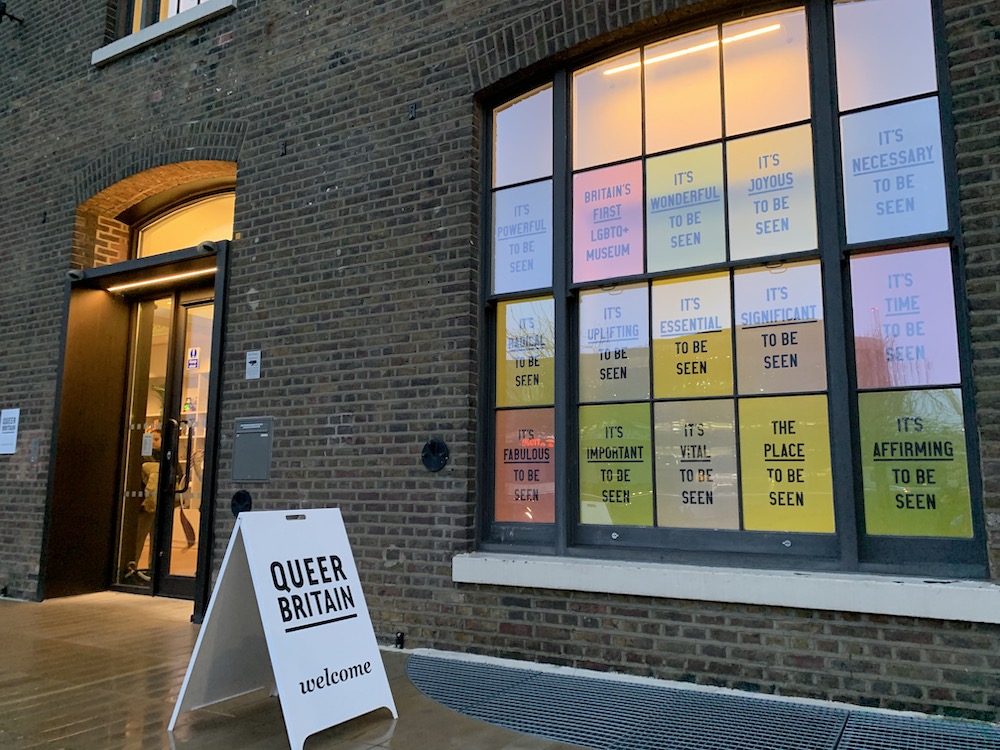
Exhibition: We Are Queer Britain
Located in a renovated Victorian industrial building, the King’s Cross space is dedicated to temporary exhibitions on LGBTQ+ themes. I visited during the inaugural exhibition We Are Queer Britain (until April 2023), marking the 50th anniversary of London’s first Pride march, which reflects on a century of activism, art, culture, and social history.
Sexual relations between men were illegal in England and Wales until 1967 (until 2000 in the armed forces), and probably the most famous person to be imprisoned for their sexuality was Oscar Wilde, author of The Picture of Dorian Gray and The Importance of Being Earnest. His cell door from Reading Gaol is on display here alongside a copy of his heartfelt testimony, which he wrote behind that door, De Profundis.
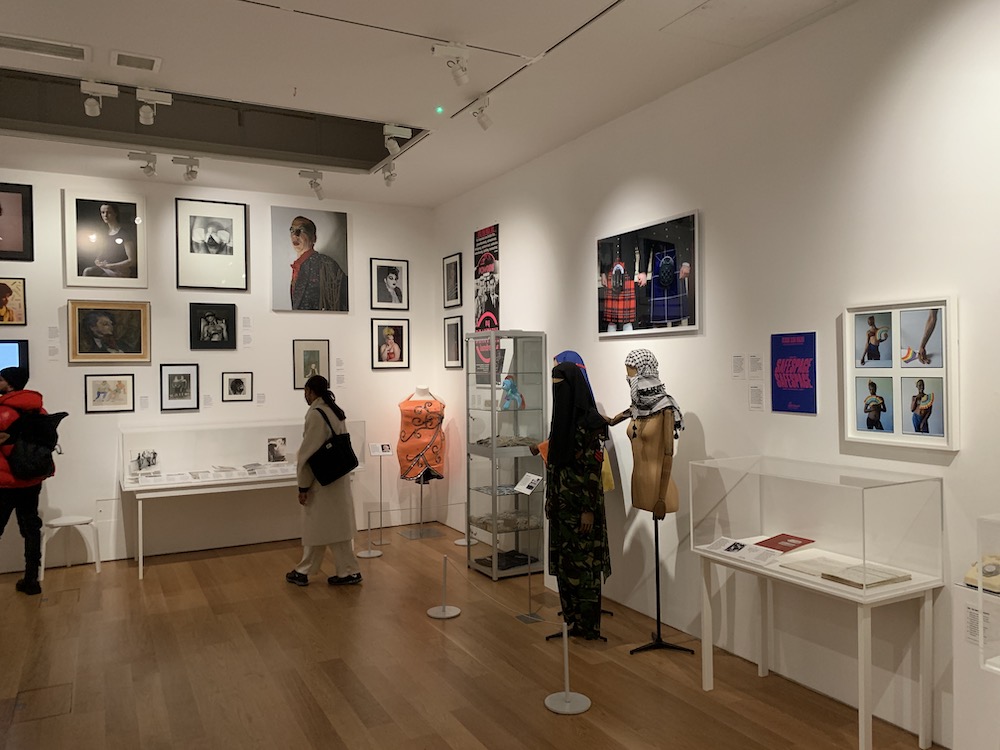
While lesbian relationships have never been illegal in this country, they have often been ignored or forgotten, and this is why queer history is so important – it reclaims stories previously left out. Often we get a glimpse into people’s lives through their diaries, such as the writer Virginia Woolf, whose bust is on display here, and 19th century Yorkshire landowner Anne Lister, whose coded diary has been called ‘the Rosetta Stone of lesbian history.’
An exciting discovery of recent years is the diary of Mr. Lucas (1926-2014) – civil servant by day and chronicler of London’s gay underworld by night. You can see a page from his diary here, and we eagerly await their full publication. Another moving document is from Switchboard, an LGBTQ+ telephone helpline founded in London in 1974 – a vital lifeline when information and support was hard to come by – and each phone call was documented in their log books, which today provide a rich insight into the issues faced by queer people from the 1970s to the 1990s, and subject of an award-winning podcast The Log Books .
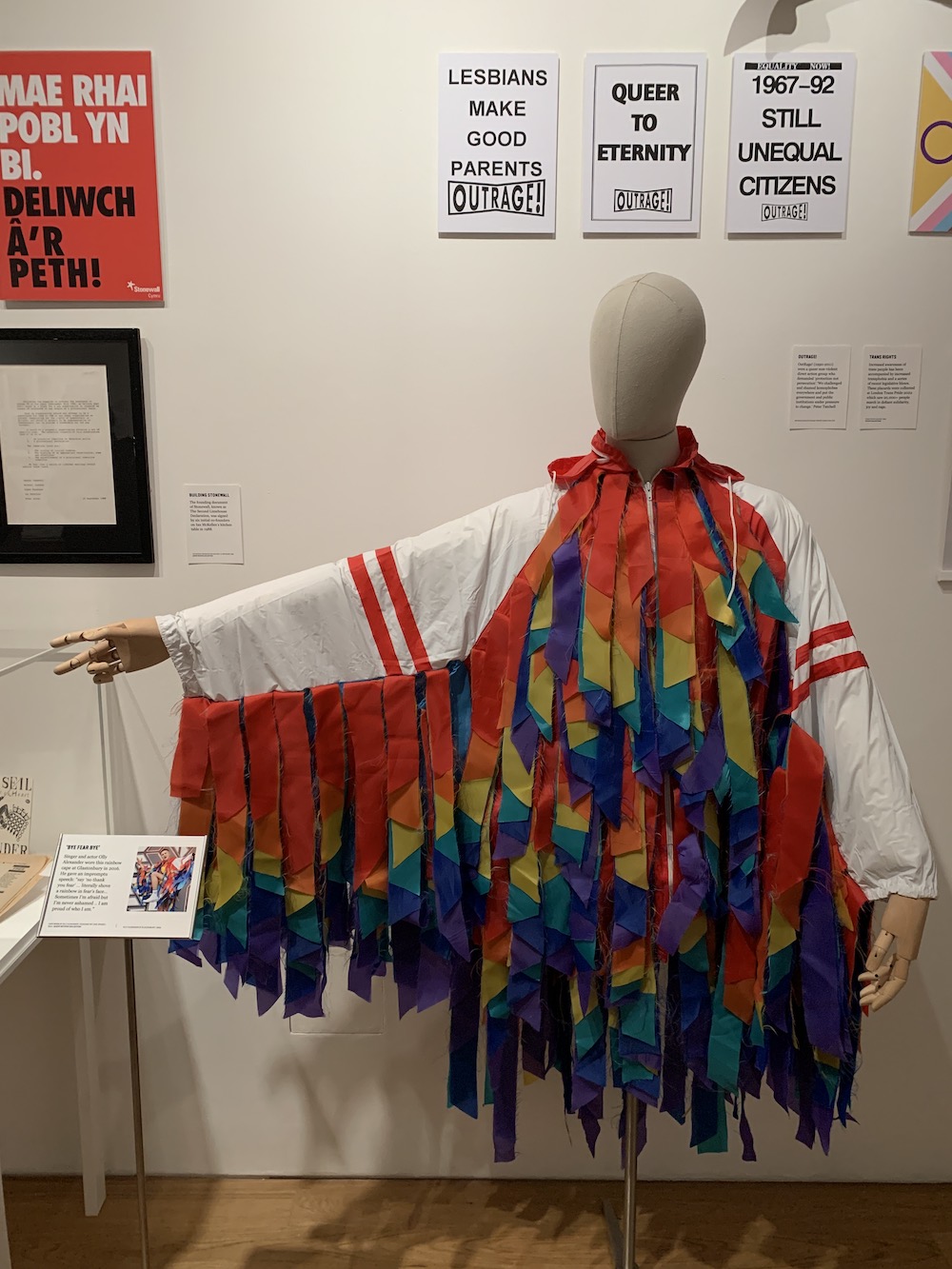
Also on display is a cabinet from the Museum of Transology, the UK’s most significant collection of objects representing trans, non-binary and intersex people’s lives, who have often been sidelined even within queer history. There are fashion items too – Pride outfits worn by members of LGBTQ+ Muslim organisation Imaan, a dress worn by the ‘Godzilla of drag queens’ Divine during their UK tour, and the rainbow cape worn by singer Olly Alexander for his Glastonbury Festival set.
As the exhibition marks the 50th anniversary of London’s first Gay Pride march (as it was called then) in 1972, there are photos and memories of early prides. For many people attending, their first pride was the first time they were ‘out’ in public and their first encounter of the size and strength of the community. The first pride commemorated the 1969 riots outside the Stonewall Inn in New York when LGBTQ+ people resisted a police raid. For this reason, the name Stonewall was chosen for the UK’s most influential LGBTQ+ charity, formed in 1989 by leading activists, including actor Ian McKellen (Gandalf in Lord of the Rings). Stonewall successfully campaigned to remove anti-LGBTQ+ laws, equalise the age of consent and introduce legal same-sex partnerships. On display is the founding document of Stonewall, signed in Ian McKellen’s kitchen.
Queer Britain packs a lot into a compact space. You can read books in the small library, curated by Gay’s The Word, Britain’s oldest LGBTQ+ bookshop based in nearby Bloomsbury. You can buy many of these books in the museum shop, along with greeting cards, mugs, and items created by selected community artists. And if you can’t make it to the museum, they have the beginnings of a digital archive on their website – you can rotate and zoom a 3-D scan of Oscar Wilde’s prison cell door.
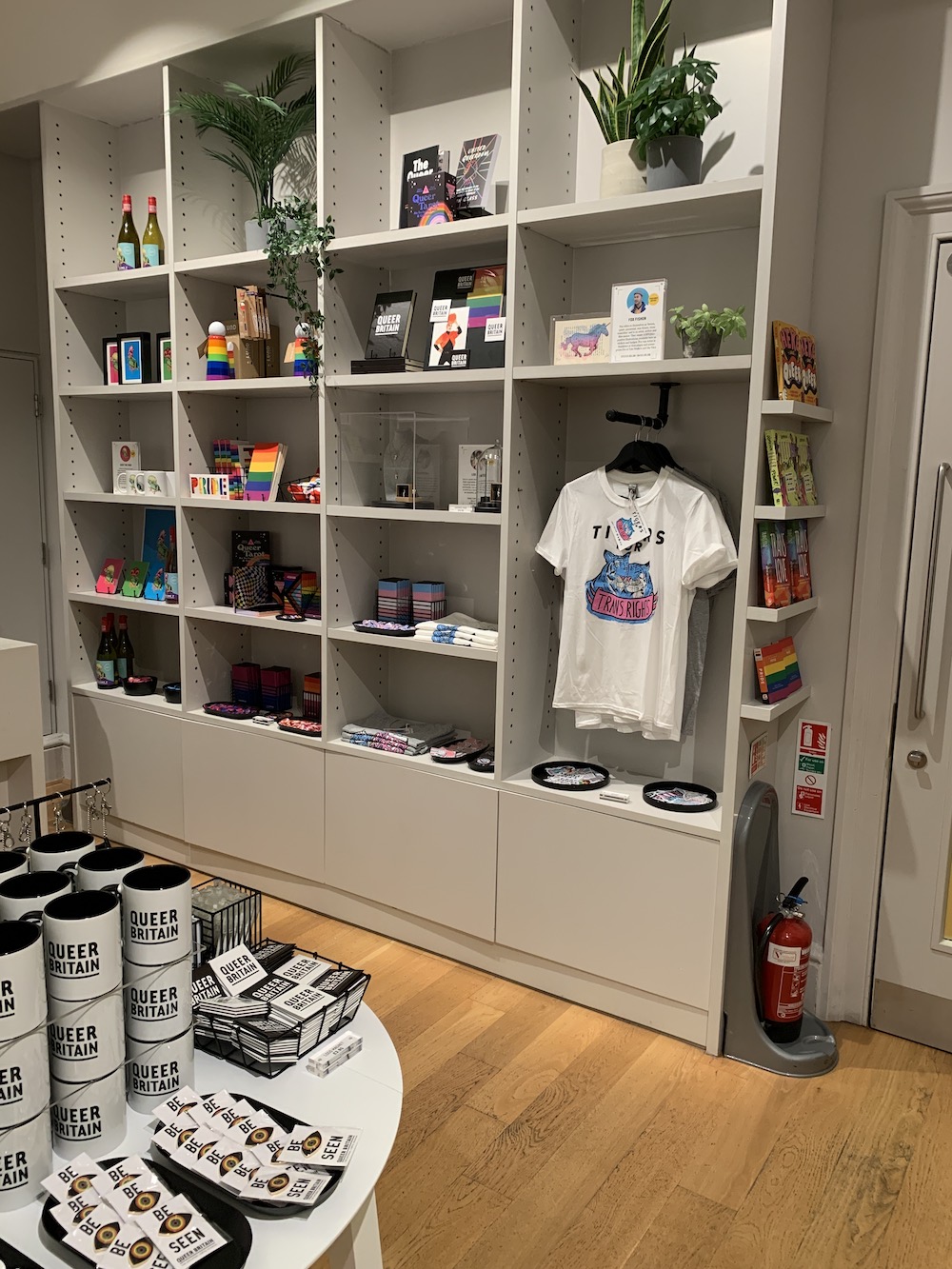
Filling in the gaps
So, why do we need a queer museum? Quite simply, it fills in the gaps. In the past (and in much of the world, in the present), people whose sexuality or gender identity differed from the norm were ignored, misunderstood, or punished. Many people protected themselves by keeping themselves off the record. On top of that, archivists and historians have overlooked, explained away (‘they were… friends’), and destroyed evidence of non-conforming lives. For instance, when bisexual poet Lord Byron died, his friends immediately rushed to his publishers in Mayfair and burned his memoirs. Who knows how many queer memories went the same way?
But far more than enriching the historical record, a queer museum helps people today understand and explore their place in the world. Many LGBTQ+ people remember a time when they were not represented in ‘respectable’ culture when there were no positive models of who they could be, when they had to figure out life on their own. Sue Sanders, the founder of LGBT+ History Month, says, ‘the difference it would have made to me as young person to know that Virginia Woolf was bisexual, to know about Oscar Wilde, would have made a phenomenal difference to my life.’ The role of community museums, we are reminded, is more than to archive dusty old relics: they have the power to crystallise shared human experiences.
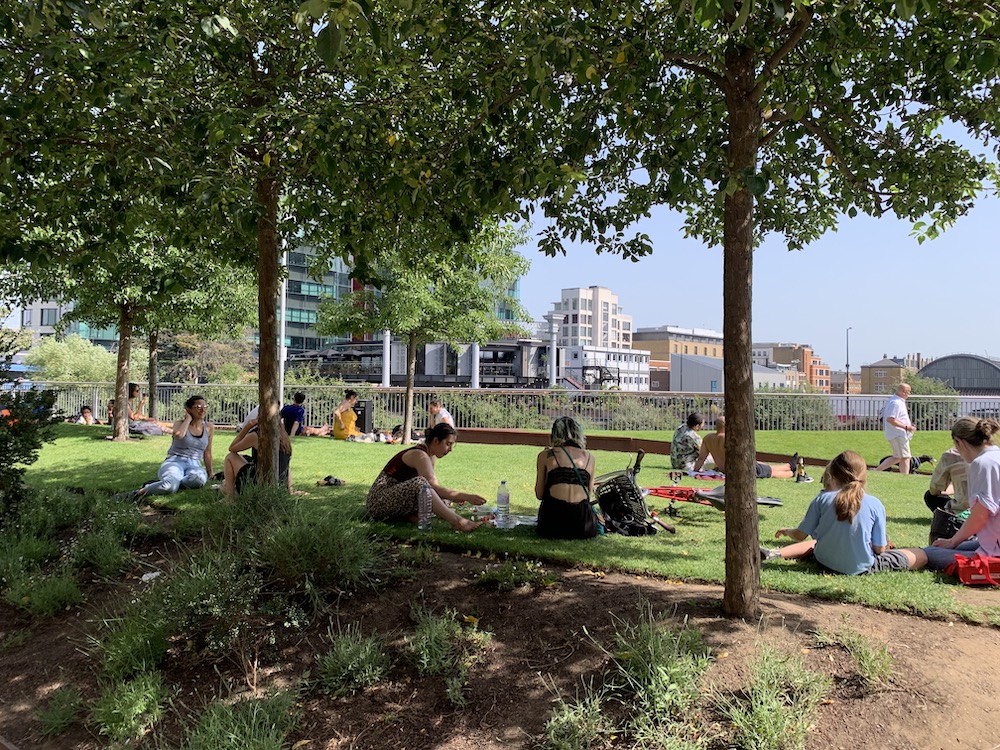
King’s Cross: London’s new public space
Another reason to visit Queer Britain is to explore the recently-redeveloped King’s Cross area – a five-minute walk north of the famous station (and its neighbour St Pancras International). In the 19th century, this was a railway, canal, and road interchange where goods from northern England were unloaded to power and feed the capital. In the 21st century, these once-derelict railway lands have been repurposed to create a vibrant area for shopping, eating, drinking, studying, and working. Queer Britain neighbours include the world-famous art college Central St Martins and the landmark new Google building (with a 300 metre-long roof garden) designed by Thomas Heatherwick, the multi-talented creator of the 2012 Olympic cauldron and the latest model of the red London bus.
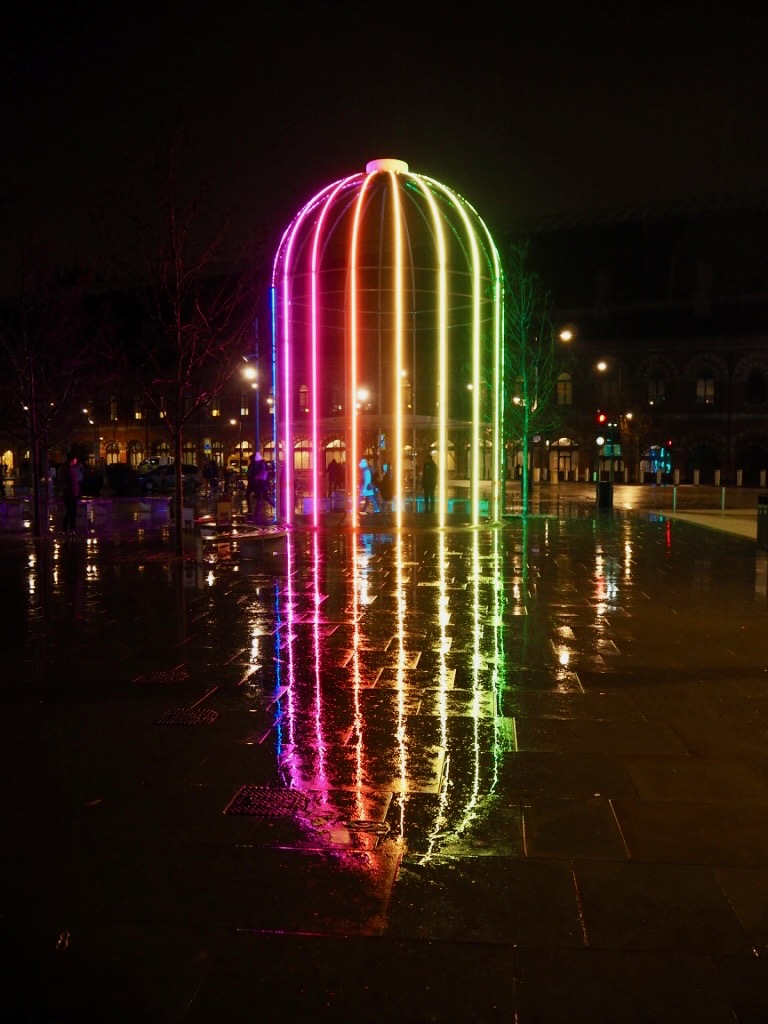
Explore further
If you want to find out more about the heritage and regeneration of the King’s Cross area around the Queer Britain museum, you can go on a London Architecture Tour – Modern and Contemporary .
If you want to explore London’s rich and varied LGBTQ+ life, the first stop would be Soho, with its bars, restaurants, and heaps of cultural heritage. For history, the nearby district of Bloomsbury was the home of many leading writers and intellectuals who we would now call LGBTQ+. Why not get the most out of your visit with an expert Blue Badge Tourist Guide?
I’ll finish with a quote from London’s first openly-gay celebrity, Quentin Crisp:
‘Time is on the side of the outcast. Those who once inhabited the suburbs of human contempt find that without changing their address they eventually live in the metropolis.’

I’m Ric and I offer friendly, thoughtful and professional guiding services in London and South East England.
I have three Blue Badges in tourist guiding: Southern England (2001), South East England (2015) and London (2021). I have a background in English language teaching and voice coaching, and I have a degree…
Leave a Reply Cancel reply
Your email address will not be published. Required fields are marked *
You may also like
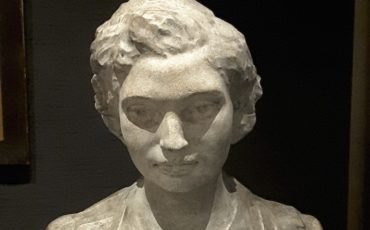
8 Exceptional Women At The British Museum in London
Did you know that the word museum means a “Temple to the Muses”, all of whom were female? The British Museum in London is a museum of world history, but all too often that history has ignored half of the world. This is true even though women have wielded power in a variety of ways. In ancient Greece, Aristotle believed it was the natural order of things for women to be subordinate to men, that men were more virtuous, brave and intelligent. He also believed that men's blood was hotter than women's blood! Well, on both counts, he was wrong of course.
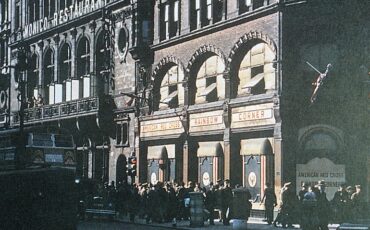
American Entertainers In London During World War II & The Venues They Played
During the Second World War London was home to, or visited by, tens of thousands of American Servicemen and women. When they wanted entertainment in the evenings they headed to the West End and the American Red Cross (ARC) Club was the first stop for many of them. There were several ARC clubs in London and many around the world offering meals and recreational activities, and the larger ones could provide overnight accommodations and facilities such as barbers and laundries.
- A-Z of London
- APTG/Guide London
- Around London
- Beyond London
- British Military
- British Monarchy
- Cathedrals & Churches
- Christmas & New Year
- Film & Television
- Food & Drink
- Major Events
- Major London Sites
- Museums & Galleries
Tower of London Tour

See the Crown Jewels and discover the darker side of history at the Tower of London
A Tower of London Tour is unmissable because…
Her Majesty’s…
VIEW TOUR NOW

Museums and Galleries
Sign up to our newsletter to receive the latest news, events and offers from London.
Would you like to receive our newsletter?
Guide London
- International edition
- Australia edition
- Europe edition

‘This is for everyone!’: inside Britain’s first ever LGBTQ+ museum
Queer Britain in north London is a bold attempt to celebrate queer history in all of its forms. At a time when the community is under attack, we need it more than ever
I t is little over half a century since homosexuality was partially decriminalised in England and Wales, and it’s a period defined by both progress and trauma. When Lord Arran co-sponsored the bill that ended the total criminalisation of same-sex relations between men – after his gay brother had killed himself – his preamble was bleak. “Lest the opponents of the new bill think that a new freedom, a new privileged class has been created,” he declared. “Let me remind them that no amount of legislation will prevent homosexuals from being the subject of dislike and derision, or at best of pity,”
After the Sexual Offences Act was passed in 1967, convictions of gay men for gross indecency actually increased, and gay people were still characterised as would-be sexual predators and threats to children. The 1980s HIV/Aids pandemic, ravaged a generation of gay and bisexual men, attitudes towards gay people hardened and a moral panic culminated in the passing of section 28 , banning the “promotion” of homosexuality in schools: the first anti-gay legislation passed since 1885. Nevertheless, in this period LGBTQ+ people flourished culturally and artistically, while from the 90s onwards, hostile public attitudes crumbled precipitously as anti-gay laws were struck from statute books.
Yet as a reminder that progress is far from linear, Britain is in the grip of another moral panic, this time directed at transgender people. And while today’s LGBTQ+ communities are more united in defiance of government policy that any time since section 28 (more than 80 organisations pulled out of a government conference over its refusal to ban trans conversion “therapy”), Stonewall , the country’s main LGBTQ+ civil rights organisation, finds itself under siege, while homophobic and transphobic hate crimes are surging.
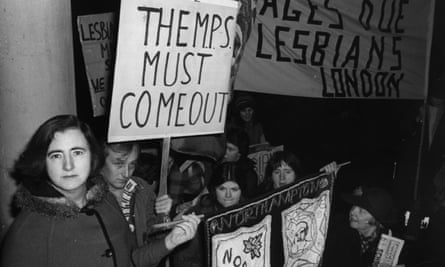
So this really is an opportune moment to launch what is, astonishingly, Britain’s first ever national LGBTQ+ museum , established by the charity Queer Britain. Opening its doors to the public on 5 May, the space is ideally situated in King’s Cross, both for Londoners and for those visiting the capital by rail. Its opening is an important milestone for a minority that has only enjoyed widespread public acceptance and significant legal protections for the briefest of periods, and is, in a sense, still blinking, slightly dazed, in the light.
Launching a museum is an ambitious endeavour, and Queer Britain has come together with impressive speed. In 2017, its director Joseph Galliano visited the Queer British Art exhibition at Tate Britain and “realised you could create a blockbuster exhibition around queer subjects”. As a former editor of Gay Times, he tapped into his extensive connections with LGBTQ+ organisations and queer activists and artists, and when he spoke to potential funders, Galliano met constant astonishment that such a museum did not already exist or even been attempted in its own right before. Relationships were quickly built with the culture sector – such as the Tate and National Trust – as well as partnerships with the likes of M&C Saatchi “to help us develop our strategic outlook”. Thanks to the efforts of its patron ambassador Carolyn Ward donations began to pour in. Far from the national lockdowns proving an obstacle, the inevitable shift to digital events helped: it was easier to get 500 people on a Zoom call than crammed into a room.
“Our donors stood by us,” says Gallianio, while a membership system allowed for people to contribute what they could afford: whether it be a pound or £100 a month. “You see people welling up as you’re talking about the museum and the vision of the museum,” he says with no little pride. “When I started seeing that happen, that was the moment that made me step back and think: OK, this is something I’ve got to really commit to making happen and commit to making it as ambitious as possible.”
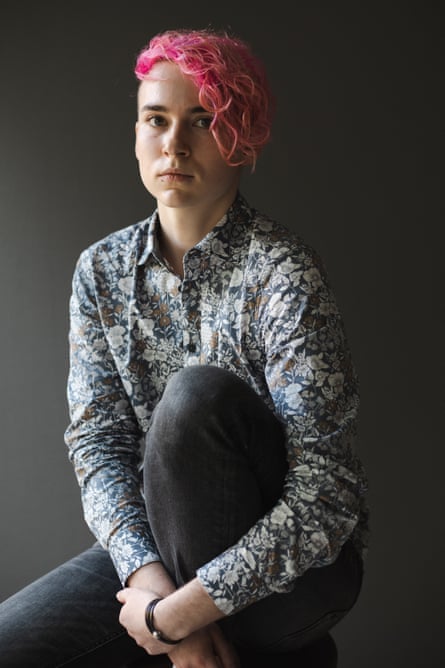
One of the key tests of this museum is representation: LGBTQ+ spaces remain dominated by white, middle-class cis men (guilty as charged!). The trustees and advisory board reflect a laudable attempt to counter that with an impressive A-team of LGBTQ+ luminaries, such as the pioneering lesbian activist Lisa Power, Huddersfield-born Black artist and curator Ajamu X, Liv Little – founder of gal-dem , the magazine for women and non-binary people of colour – and the indefatigable trans author Christine Burns. As Galliano, ushers me into the museum – for now, three rooms of photographs serving as a holding pattern before its big summer exhibition in July – the commitment to that mission is commendably clear: queer families of colour, all conveying joy and love, adorn the walls. Why is this so important? Because the oppressed can be oppressors, too; research by Stonewall in 2018 found around half of Black, Asian and minority ethnic LGBTQ+ people suffered racial discrimination from local LGBTQ+ networks, rising to 61% among Black LGBTQ+ people.
“We built a board to make sure that there’s proper leadership structures that are diverse in themselves, as well as bringing in more skills that we need,” says Galliano. Uplifting underrepresented sections of the community is “absolutely written into the DNA”, with its first project being an oral history collection on those groups, accompanied by focus groups with representation from LGBTQ+ people with different and often intersecting identities.
“This will not be easy if we’re to truly transcend tokenism,” the trustee and Black photographer Robert Taylor tells me, “but I’m encouraged by what I’ve seen so far.” It’s so easy to be “unconsciously excluding”, he says, and he wants to “keep an eye out for comfortable unconscious assumptions about what we’re doing, how and for whom.” Or, as Lisa Power tactfully puts it: “We love our cis white men but they’re part of a bigger story.”

Britain’s often tortured struggle for LGBTQ+ rights is reflected in many of the photographs, such as the flamboyantly dressed yet straight Jewish Labour MP Leo Abse, who successfully pushed for the partial decriminalisation of homosexuality from the backbenches . Maureen Colquhoun – the first openly lesbian MP who died last year – defiantly holds a placard emblazoned with “THE MPS MUST COME OUT”, while it’s difficult not to feel a pang of sadness at a photo of Justin Fashanu flexing his muscles: he was, of course, Britain’s first and still only out gay male professional footballer who killed himself in 1998. Such a collection would not be complete without that unlikeliest of LGBTQ+ allies, Diana, Princess of Wales, who helped upend the stigma of Aids, and is pictured lovingly touching the hand of an HIV patient.
This is a museum with huge potential. It includes space for events which – given that, unlike other major western capitals, London lacks a permanent LGBTQ+ community space – could make it a vital hub. There are, however, problems that the museum surely needs to interrogate in advance of the summer exhibition. One photograph, for example, features a Metropolitan police officer joyfully high-fiving a London Pride attender. That same police force has been criticised as institutionally homophobic by the families of the four men murdered by Stephen Port over its failure to investigate the so-called “Grindr killer”. Is the picture really appropriate, I ask Galliano. There’s a pause which seems to last a lifetime. “I think you make a good point, which I’d like to have a more considered answer for,” he tells me. “There’s a fuck of a lot to do in getting something like this set up, and it’s a lot of spinning plates, and the thing is you get some of them wrong.”
There is a lack of expression, so far, of queer love, too – of a non-familial sort, anyway – and sexuality, with the exception of a picture of the lower torsos of two kilted men holding hands. This is a family space, of course, and no one reasonable would expect full-frontal nudity, but it’s striking that the walls of a queer east London bar such as Dalston Superstore feature more challenging images about such important elements of the LGBTQ+ experience. It should be hoped, too, that the upcoming summer exhibition features more images of struggle: there are allusions, such as a Black woman holding a “LESBIAN AND GAY PRIDE ’83” balloon, but there are so many joyous moments to celebrate that are in danger of being forgotten by younger LGBTQ+ generations, such as the lesbian activists who abseiled into the House of Lords or stormed the Six O’Clock News to protest against section 28. “Wait for the summer exhibition,” says Galliano. Where I disagree with Galliano, though, is when he suggests “it’s very easy to kind of go ‘struggle, victimhood, difficulty’”: these moments should surely be seen as courageous acts of agency which spurred on change.
Given the full-frontal offensive against trans people it is welcome to see representation, including two portraits of trans people from award-winning photographer Allie Crewe’s You Brought Your Own Light collection. “As a trans person myself I am always surprised that the rights won by LGBTQ+ communities to date were very much won with trans siblings in the day-to-day struggles and fights from the outset,” says trustee and businessperson Antonia Belcher, “yet that representation has not materialised the same recognition for trans people – hardly fair.” She fears the museum may not succeed in challenging entrenched attitudes among older Britons, but it will be “welcomed by younger generations, like my own children and grandchildren, who are naturally inclusive”.
So who is this museum for? “It’s for everyone!” says Anjum Mouj, trustee and board member of Imaan, the Muslim LGBTQ+ group. She wants LGBTQ+ and heterosexual people alike to visit, with parents taking their queer and straight children; and for the museum to look beyond Britain’s borders, in a world in which 69 nations and territories still criminalise same-sex relationships. In its first year, the museum hopes to attract 26,000 people through its doors. It is easy to be pernickety about ambitious and well-intentioned new projects – this one has been four years in the making – but any critiques should surely be about wishing this endeavour well. It will make mistakes, but with such commendable representation among its trustees and advisers, and a genuine commitment to listen to LGBTQ+ communities, there are huge grounds for optimism.
In the half-century since criminalisation of male homosexuality was partly repealed, Britain’s LGBTQ+ communities have made dramatic contributions to British culture and society, often while faced with tremendous adversity. We surely deserve our own museum to remind us how our rights were won – at huge cost and sacrifice – as well as showcasing how we have flourished.
Quee r Britain is at 2 Granary Square, London, N1, and will open to the public on 5 May.
- LGBTQ+ rights
- Transgender
- Photography
Most viewed
THE 10 BEST Moscow Museums
Museums in moscow.
- Specialty Museums
- Art Galleries
- Art Museums
- History Museums
- Children's Museums
- Science Museums
- Military Museums
- Natural History Museums
- Observatories & Planetariums
- 5.0 of 5 bubbles
- 4.0 of 5 bubbles & up
- 3.0 of 5 bubbles & up
- 3rd Transport Ring (TTK)
- District Central (TsAO)
- Garden Ring
- Boulevard Ring
- Good for a Rainy Day
- Budget-friendly
- Good for Kids
- Good for Big Groups
- Hidden Gems
- Good for Couples
- Adventurous
- Honeymoon spot
- Good for Adrenaline Seekers
- Things to do ranked using Tripadvisor data including reviews, ratings, photos, and popularity.

1. State Tretyakov Gallery

2. Tsaritsyno Museum-Reserve

3. Moscow Kremlin
4. Armoury Chamber

5. Kolomenskoye Historical and Architectural Museum and Reserve

6. The Museum of Cosmonautics

7. Kuskovo Estate
8. Pushkin State Museum of Fine Arts
9. New Tretyakov Gallery

10. State Darwin Museum
11. Diamond Fund (Almazny Fond)
12. Jewish Museum and Tolerance Center
13. Experimentanium Museum of Entertaining Sciences

14. Art Gallery of the European and American Countries of the XIX-XX centuries

15. Museum of Soviet Arcade Machines
16. Muzeon Art Park
17. Mikhail Bulgakov State Museum
18. Moscow Planetarium
19. Museum-Diorama Tsar-Layout

20. Orlov Paleontological Museum
21. Historical Park Russia - My History
22. Entertainment Center Arbat 16
23. Bunker-42 Cold War Museum at Taganka
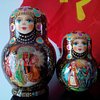
24. The State A.S. Pushkin Museum
25. Museum Moskovskiy Transport

26. Novospasskiy Monastery

27. Victor Vasnetsov House Museum
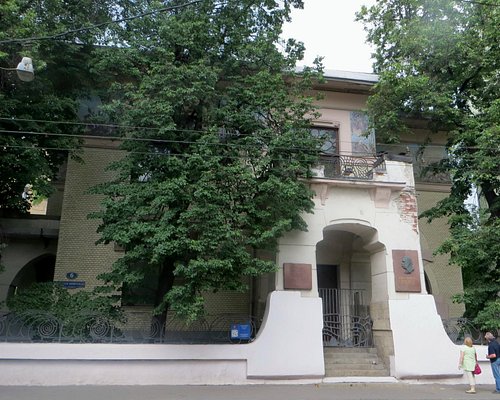
28. Gorky's House (Ryabushinsky Mansion)
29. Artplay Design and Architecture Center

30. The Victory Museum
What travelers are saying

- State Tretyakov Gallery
- Moscow Kremlin
- Tsaritsyno Museum-Reserve
- The Museum of Cosmonautics
- Armoury Chamber
- Museum-Diorama Tsar-Layout
- Victor Vasnetsov House Museum
- Museum Moskovskiy Transport
- Kolomenskoye Historical and Architectural Museum and Reserve
- Diamond Fund (Almazny Fond)
- Art Gallery of the European and American Countries of the XIX-XX centuries
- Kuskovo Estate
- Muzeon Art Park
- Jewish Museum and Tolerance Center
- Orlov Paleontological Museum
- Novospasskiy Monastery
- Historical Park Russia - My History
- Experimentanium Museum of Entertaining Sciences
- Mikhail Bulgakov State Museum
- Museum of Soviet Arcade Machines
- Entertainment Center Arbat 16
- Bunker-42 Cold War Museum at Taganka
- Museum of Illusions
- Museum of Death
Destination guides
Download free Russia travel guides
- St Petersburg
- Golden Ring
- Lake Baikal
- Murmansk (Kola Peninsula)
- Moscow & St Petersburg
- Russia River Cruises
- Expedition Cruises
- Trans-Siberian Tours
- Northern Lights Tours
- Siberia Tours
- Winter Tours
- Students Trips
- Luxury Tours
- Plan My Tour
Start planning my tour
Your Russia, your dates, your mates
- Destination Guides
- Russia Travel Tips
- Russian Visa
- Travel Insurance
- Why 56th Parallel
- Traveller Reviews
Moscow Vibes – Three Day City Escape
Duration 3 days
Price from USD $730 ? Currency Conversion Converted from USD based on the latest exchange rate. Final amount and payment will be in USD. Final conversion rate is determined by your bank.
Trip Style Sightseeing
Time of year All Year
Home / Moscow Tours / Moscow Vibes – Three Day City Escape
- Dates & Prices
This short Moscow tour will give you a true taste of the history, culture and incomparable urban vibe that define one of the world’s largest metropolises. In just three days, this Moscow itinerary takes in all the most iconic sights of this attraction-packed destination. After two and half days getting acquainted with the city, we’ve set time aside for you to explore Moscow your way and discover your own favourite hang-outs in a city overflowing with hidden treasures
3-Day Moscow Tour Highlights:
- Panoramic Tour of Moscow: See Moscow beyond the postcard images on a private excursion by car through the city streets including a drive along the banks of the Moskva River. Visit the famous Bolshoi Theatre, pass by Gorky Park and the Novodevichy Convent, and admire the city from on high at the Sparrow Hill observation platform.
- Moscow Historical City Centre Guided Walking Tour : Immerse yourself in the atmosphere of one of the world’s biggest metropolises and discover local haunts on foot, including the Red Square, the Kremlin and the multi-coloured domes of St Basil’s Cathedral.
- Armory Chamber tour: Explore the endless treasures of this unique museum, displaying the wealth accumulated by Russian rulers from the 12th century until the October Revolution of 1917. Walking through the exhibition halls is a journey through the centuries.
- Moscow Metro Tour : Go deep underground on a subway tour of the famous Moscow metro. The world’s deepest metro system is renowned for its palatial, art-adorned stations, complete with marble columns and chandeliers.
On your first day, you’ll be treated to a panoramic, drive-by tour of Moscow to get a feel for the immense scale of one of the world’s most rapidly developing urban centres. The city’s history unfolds in real-time as you pass lavish imperial mansions, solemn Soviet structures and luxurious modern shopping centres.
Day two kicks off exploring Moscow’s historic centre on foot, followed by a tour of the Kremlin, the seat of Russian power and political intrigue for centuries. Stand in the Red Square, surrounded by the stunning architecture as you hear stories of the people and events behind many of Moscow’s most iconic landmarks.
On your final day, we’ll head beneath the city for a tour of the Moscow Metro and its famously ornate underground stations. Art lovers should hit up one of Moscow’s many world-class galleries such as the Tretyakov State Gallery, the Pushkin Museum or Garage, Moscow’s cutting-edge contemporary art museum. History fans can follow a Soviet trail through the city including Stalin’s Bunker, while those seeking a more indulgent experience can browse trendy neighbourhoods like Kitay Gorod or shop for everything from fashion to kitsch souvenirs at the enchanting Izmaylovo Flea Market. Foodies can head to one of the countless speciality stores sampling vodka, caviar and chocolate.
If you only have a few days to spend in Moscow, this tour will ensure you make the most of your time in the city. Let the experts navigate you through this complex and occasionally overwhelming capital, giving you plenty of time to soak up the city’s most unmissable attractions.
Accomodation
Not Included
Sightseeing
Action rating ?
Type of tour
3 days / 2 nights
Private - Any Date
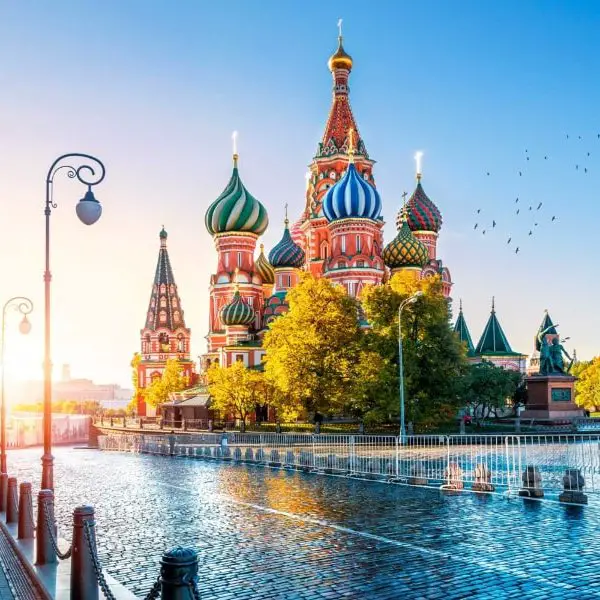
Day 1 Panoramic city tour
Welcome to the glorious capital of Russia, Moscow! You’ll be met by your driver at the airport and taken to your centrally located hotel.
After check-in and rest, meet your private guide at the hotel lobby for a comprehensive tour of Moscow by car. Visit the starkly contrasting Theatre Square to see the stunning Bolshoi Theatre, pass Tverskaya Street, the city’s main boulevard and home to the landmark Yeleseyevskiy Grocery Store.
You’ll enjoy a panoramic drive along the Moskva River, where a huge, controversial state of Peter the Great was erected. Pass by the legendary Gorky Park and the White House before a stop at the architecturally stunning Novodevichy Convent, and the observation platform at Sparrow Hills, for a bird’s eye view over this staggering megalopolis.
Day 2 Red Square and Kremlin
After breakfast at the hotel, your guide will take you on a walking tour of the historical city centre. Stroll through the Red Square, the hub of cultural life in Moscow, with its elaborate ‘stone flower’ fountain and fantasy-like St Basil’s Cathedral – a postcard-perfect symbol of the nation. Admire the grandiose façade of GUM, the city’s most luxurious shopping centre, and visit Alexander’s Garden, with its eternal flame and the chance to watch a changing of the guards.
Break for lunch before continuing on a tour of the Kremlin and Armoury Chamber, famous of its collection of tsarist fashion, with regalia such as jewel-encrusted crowns, orbs and sceptres as well as arms and armour, exotic gifts from the leaders of faraway lands, and an illustrious case of Imperial Faberge eggs.
As an option* spend an evening on a sumptuous dinner cruise, taking in the stunning sights and city lights of this mesmerising metropolis by night.
Day 3 Metro and Arbat Street
Start a day with a tour of Metro, stopping on the way to marvel at some of the most elaborately decorated stations of the world-famous Moscow subway system. Take a stroll along Old Arbat street - the most famous street in Moscow. Through the centuries Arbat used to be one of the most bohemian places in Moscow. Today Arbat is a promenade full of small cozy cafes and street life.
The afternoon is free for you to either enjoy the rest of the day on your own or choose among optional excursions to explore more of Moscow. Visit the Tretyakov Gallery or Pushkin State Museum to admire Russian art. Join locals for a stroll at the Gorky or VDNH park.
Visit beautiful Kolomeskoye Estate or Izmailovo Kremlin, or spend a day exploring the beautiful city of the Golden Ring (Russian province) - Sergiev Posad. In the evening you will be transferred to the airport for your departure to your next destination.

Print this page
Save a printed version of this tour, so you can make a decision later

Send to my inbox
Email yourself or a friend the link for this tour

Ask a question
Have a question about this tour? Our experts will be happy to help
Group airport/train-station arrival and departure transfers
All transportation according to the itinerary with a private driver
4* hotel accommodation in the historical city center (twin/double)
Local licensed English-speaking guide
All activities, indicated in the itinerary, except optional
Entry fees according to the itinerary (skip-the-lines policy)
Russian visa support document
Travel insurance
Russian visa and visa fees. Russian visa can be arranged by 56th Parallel for an additional cost (for Australian citizens only). Apply for concierge visa service here .
Optional excursions/activities
*Private tour. Price is per person, based on min 2 people
Similar tours
Highlights of moscow & st petersburg.
Immerse yourself in the art, history and culture of Russia and explore the contrasting styles of Moscow and St Petersburg in just one week. Experience the iconic landmarks of ...
Golden Ring at a Glance
Take a short detour from Moscow to discover the age-old allure of Russia. Travelling from the capital to the countryside, where golden spires and the onion-shaped domes of ...
Treasures of St Petersburg
This in-depth tour is a fun and fascinating discovery of the legacy of Imperialist Russia, just in one week. A showcase for the wealth and tastes of the Emperors of Russia from ...
Classic Moscow – Art, History and Culture
Breathe in the history of Moscow, explore its Imperial and soviet past, dynamic contemporary culture and lifestyle. On this 5-day tour of Moscow, you'll visit the must-see sights ...
Why travel to Russia with 56th Parallel?
Destination Specialists
Our team offers over 18 years of experience travelling and planning travel in Russia. Delivering outstanding travel experiences in Russia’s capitals and in some of the most stunning & remote locations takes experience, special access and the right connections. We make sure that all the fine details are handled perfectly so you can enjoy your Russia travel experience.
Group & Private Tours
The choice to join a small group on a guaranteed departure or chose to travel on your own dates with your own mates. Each destination we travel to in Russia offers an option between private tours and small group tours. Please note: on our adventure tours in remote destinations, we mostly run group tours to keep the cost down.

Bonded & Licensed
56th Parallel is a fully licensed, insured and accredited travel provider.

From USD $730
Day 1: Panoramic city tour
Day 2: red square and kremlin, day 3: metro and arbat street, not included, start planning your tour.
A destination specialist will follow up on you enquiry shortly. Prefer to chat? Call us on +61 412 587 785 we will be delighted to be of service.
Email this tour to:
Have a question or need specific information.
Send us a note below or call us
Country * Afghanistan Albania Algeria American Samoa Andorra Angola Anguilla Antarctica Antigua and Barbuda Argentina Armenia Aruba Australia Austria Azerbaijan Bahamas Bahrain Bangladesh Barbados Belarus Belgium Belize Benin Bermuda Bhutan Bolivia Bosnia and Herzegowina Botswana Bouvet Island Brazil British Indian Ocean Territory Brunei Darussalam Bulgaria Burkina Faso Burundi Cambodia Cameroon Canada Cape Verde Cayman Islands Central African Republic Chad Chile China Christmas Island Cocos (Keeling) Islands Colombia Comoros Congo Congo, the Democratic Republic of the Cook Islands Costa Rica Cote d'Ivoire Croatia (Hrvatska) Cuba Cyprus Czech Republic Denmark Djibouti Dominica Dominican Republic East Timor Ecuador Egypt El Salvador Equatorial Guinea Eritrea Estonia Ethiopia Falkland Islands (Malvinas) Faroe Islands Fiji Finland France France Metropolitan French Guiana French Polynesia French Southern Territories Gabon Gambia Georgia Germany Ghana Gibraltar Greece Greenland Grenada Guadeloupe Guam Guatemala Guinea Guinea-Bissau Guyana Haiti Heard and Mc Donald Islands Holy See (Vatican City State) Honduras Hong Kong Hungary Iceland India Indonesia Iran (Islamic Republic of) Iraq Ireland Israel Italy Jamaica Japan Jordan Kazakhstan Kenya Kiribati Korea, Democratic People's Republic of Korea, Republic of Kuwait Kyrgyzstan Lao, People's Democratic Republic Latvia Lebanon Lesotho Liberia Libyan Arab Jamahiriya Liechtenstein Lithuania Luxembourg Macau Macedonia, The Former Yugoslav Republic of Madagascar Malawi Malaysia Maldives Mali Malta Marshall Islands Martinique Mauritania Mauritius Mayotte Mexico Micronesia, Federated States of Moldova, Republic of Monaco Mongolia Montserrat Morocco Mozambique Myanmar Namibia Nauru Nepal Netherlands Netherlands Antilles New Caledonia New Zealand Nicaragua Niger Nigeria Niue Norfolk Island Northern Mariana Islands Norway Oman Pakistan Palau Panama Papua New Guinea Paraguay Peru Philippines Pitcairn Poland Portugal Puerto Rico Qatar Reunion Romania Russian Federation Rwanda Saint Kitts and Nevis Saint Lucia Saint Vincent and the Grenadines Samoa San Marino Sao Tome and Principe Saudi Arabia Senegal Seychelles Sierra Leone Singapore Slovakia (Slovak Republic) Slovenia Solomon Islands Somalia South Africa South Georgia and the South Sandwich Islands Spain Sri Lanka St. Helena St. Pierre and Miquelon Sudan Suriname Svalbard and Jan Mayen Islands Swaziland Sweden Switzerland Syrian Arab Republic Taiwan, Province of China Tajikistan Tanzania, United Republic of Thailand Togo Tokelau Tonga Trinidad and Tobago Tunisia Turkey Turkmenistan Turks and Caicos Islands Tuvalu Uganda Ukraine United Arab Emirates United Kingdom United States United States Minor Outlying Islands Uruguay Uzbekistan Vanuatu Venezuela Vietnam Virgin Islands (British) Virgin Islands (U.S.) Wallis and Futuna Islands Western Sahara Yemen Yugoslavia Zambia Zimbabwe
If you have any urgent questions or enquiries, please give us a call +61 412 587 785
- Guided tour
Moscow: City Sightseeing by Car/Bus
- Description
- Choose date

Visiting a new city is akin to going on a first date, it is something you will never forget. Many people imagine Moscow as just a bunch of sporadic landmarks: Red Square, the Kremlin, Lenin’s Mausoleum and GUM. There is so much more to this wonderful city than that and even though we only have a few hours, we will do all we can to show you everything we know and love about our capital in one fell swoop. We will take you on a journey through the ages, from centuries ago, right up to the modern day, soaking in the sights of this vast and bustling metropolis. Bright, luxurious and both ancient and modern at the same time, Moscow invites you on a date you’ll never forget!
On our sightseeing bus tour of the city, you will see:
- The wonderfully historic city centre and its unique museums, magnificent cathedrals, the exquisite Chambers of the Romanov Boyars and of course, the famous towering red brick walls of the Kremlin, The charming beauty of the Alexander Garden awaits the capital's guests - a lush green oasis in the midst of the glass and concrete clad metropolis, basking in the etherial aura emanating from the whitewashed stone walls of the restored Cathedral of Christ the Saviour, the world- renowned fairytale onion domes of St. Basil's Cathedral and other impressive monumental buildings such as the library built in Lenin's honour - the Russian State Library - and the State Duma.
- The Lubyanka KGB headquarters is notorious to members of older generations and although nowadays, the face of the secret police has changed dramatically, the looming enigmatic building on the waterfront maintains its aura of mystery, shrouded in a variety of murky rumours and dark myths. Then, there’s another of Moscow's main attractions - the marvellous Bolshoi Theatre, yew simply cant leave Moscow without taking in its breathtaking architecture. Engrained in the fabric of Russia's cultural heritage, virtuoso performers such as prima ballerina Galina Ulanova, opera singer Feodor Chaliapin and pianist, composer and conductor Sergei Rachmaninoff once stood centre stage of this vaunted institution.
- The memorial complex on Poklonnaya Hill was constructed in the glory and honour of our heroes who defended our nation in the many crucial battles of the Great Patriotic War (WWII). This is a place that embodies a particularly acute and inextricable link between older ancf younger generations. Moving on to the Moscow International Business Centre, not dubbed ‘Moscow City' for nothing, a true glimpse of the future in the present. This incredible, rather jaw-dropping project in the capital has shown that Moscow has come to accept the age of the skyscraper. Finally, the stunning views from the observation deck at Sparrow Hills will leave professional and amateur photographers alike itching to capture them. How could one resist?
The most beautiful of all the world's cities - lady Moscow invites you out on a date!
The cost of an excursion with a personal guide for 1 person
Meeting point We'll pick you up at your hotel
St. Basil's Cathedral
House on the Embankment
Cathedral of Christ the Saviour
Vorobyovy Hills
Poklonnaya Hill Poklonnaya Gora
Moscow-City
Alexander garden
Russian State Library
Bolshoi Theatre
End of the tour
Choose your dates
Select time, who's going.
- Excursion Moscow: City Sightseeing by Car/Bus
- Date and time:
- Who's going:

IMAGES
COMMENTS
Explore objects in the collection linked to the themes of desire, love and identity. Join our volunteer-led tour and discover a fascinating selection of objects with LGBTQ (lesbian, gay, bisexual, transgender and queer) connections. The tour ranges from the ancient world to the present day, and includes some of the most famous artworks on display.
This selection of objects was inspired by Richard Parkinson's book A Little Gay History - Desire and Diversity Across the World, and was originally developed to accompany a display and trail in the British Museum from the 11 May-15 October 2017 entitled Desire, Love, Identity: exploring LGBTQ histories. The display was supported by Stephen ...
The initiative builds on LGBTQ audio tours at the museum. "We'll see how they go, see what the demand is," said Sarah Saunders, the head of learning and national programmes at the museum ...
The museum has launched a brand new initiative of LGBTQ-themed guided tours, which have been created as an extension of the self-led LGBTQ "trail" around the museum, launched in 2018. About a dozen volunteer staff members will be guiding guests around some of the museum's most famous LGBTQ objects, according to the museum — many of them ...
Mon 25 Jun 2018 19.01 EDT. The British Museum has gathered a collection of objects with LGBTQ connections, including the world's oldest known depiction of a couple having sex - an 11,000-year ...
queer britain museum ltd is a charitable company limited by guarantee. company number 11253032 / charity number 1180240 registered office 2 granary square, king's cross, london n1c 4bh. queer britain® is a ...
Queer Britain: the UK's First LGBTQ+ Museum. In May 2021, Queer Britain, the UK's first museum dedicated to LGBTQ+ (lesbian, gay, bi, trans, queer) history and culture, opened in the King's Cross area of London. Located at 2 Granary Square, it joins destinations including Berlin, San Francisco, and Fort Lauderdale in having a permanent ...
Photograph: Wesley/Getty Images. So this really is an opportune moment to launch what is, astonishingly, Britain's first ever national LGBTQ+ museum, established by the charity Queer Britain ...
Queer Britain on Granary Square is the UK's first museum of Queer culture and boasts a fascinating archive as well as the world's first virtual reality museum dedicated to celebrating the stories and artwork of LGBTQIA+ people and preserving queer personal histories. The space also houses a shop selling Queer Britain merchandise and a ...
Desire, love, identity - an LGBTQ tour of the British Museum. Choose another item. Use the dropdown list below to select another date: Go to selected item. Back to events calendar Item details Date. Saturday 23 September 2023 2:30PM. Sold out! British Museum. Contact us Great Russell Street London WC1B 3DG +44 (0) 20 ...
State Museum-Reserve Tsaritsyno - a beautiful reserve in the southern part of Moscow, with the largest palatial ensemble in Russia. Bolshoi Theatre - world-famous theatre with regular shows. Novodevichy Convent - built in the early 1500's and has remained nearly intact for centuries, this is one of Moscow's best-preserved historical complexes.
22. Entertainment Center Arbat 16. We decided to visit the Maze of Fear (18+), the Mirror Maze (18+ on New Arbat, 0+ on Old Arbat), The Museum of... 23. Bunker-42 Cold War Museum at Taganka. ... which you need to get the history of the bunker from WWII/Great Patriotic War period to the more recent history. 24.
3-Day Moscow Tour Highlights: Panoramic Tour of Moscow: See Moscow beyond the postcard images on a private excursion by car through the city streets including a drive along the banks of the Moskva River. Visit the famous Bolshoi Theatre, pass by Gorky Park and the Novodevichy Convent, and admire the city from on high at the Sparrow Hill ...
On our sightseeing bus tour of the city, you will see: The wonderfully historic city centre and its unique museums, magnificent cathedrals, the exquisite Chambers of the Romanov Boyars and of course, the famous towering red brick walls of the Kremlin, The charming beauty of the Alexander Garden awaits the capital's guests - a lush green oasis in the midst of the glass and concrete clad ...